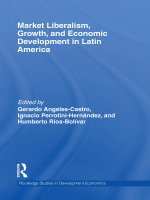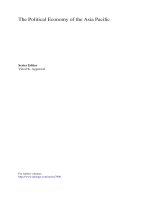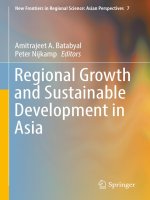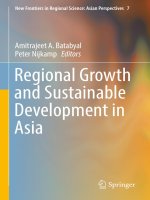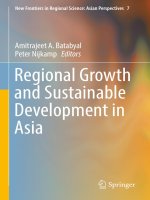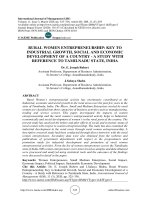Economic growth and economic development 158
Bạn đang xem bản rút gọn của tài liệu. Xem và tải ngay bản đầy đủ của tài liệu tại đây (109.91 KB, 1 trang )
Introduction to Modern Economic Growth
identical homothetic preferences imply that
(3.29)
XjK
XjH
=
=
Akj Kj
Ahj Hj
−
csj
−
csj
N
X
Aki Ki
i=1
N
X
Ahi Hi
i=1
where csj is the share of country j in world consumption (the value of this country’s
consumption divided by world consumption) and N is the total number of countries in the world. These equations simply restate the conclusion in the previous
paragraph that a country will be a net exporter of capital if its effective supply of
capital, Akj Kj , exceeds a fraction, here csj , of the world’s effective supply of capital,
PN
k
i=1 Ai Ki .
Consumption shares are easy to calculate. Then given estimates for XjK and
XjH , the above system of 2 × N equations can be solved for the same number of
unknowns, the Aki and Ahi ’s for N countries. If we stopped here, we would have
obtained estimates for factor-specific productivity differences across countries from
an entirely different source of variation than those exploited before. In addition, we
would not have a single productivity parameter, but a separate labor-augmenting (or
human-capital-augmenting) and a capital-augmenting productivity for each country,
which is not an uninteresting achievement.
However, if we indeed stopped here, we would not know whether these numbers
provide a good approximation to cross-country factor productivity differences. This
is in some sense the same problem as we had in judging whether the calibrated productivity (technology) differences in the previous section were reliable. Fortunately,
international trade theory gives us one more set of equations to check whether these
numbers are reliable. As noted above, under the assumption that the world economy
is sufficiently integrated, we have conditional factor price equalization. This implies
that for any two countries j and j 0 , we must have:
(3.30)
(3.31)
Rj 0
Rj
=
,
k
Aj
Akj0
wj
wj 0
=
,
h
Aj
Ahj0
144
